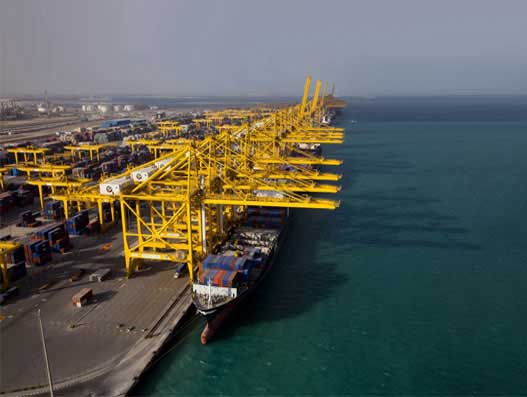
Green strategies for sustainable ports
Port economy and ecology – do they go together? Both the private sector and public institutions are investing a lot of money and making great efforts to fulfil their responsibility for an ecologically sustainable port operation. Sea transport is the most environmentally friendly mode of transport worldwide. In terms of overall CO2 emissions, navigation accounts […]

Port economy and ecology – do they go together? Both the private sector and public institutions are investing a lot of money and making great efforts to fulfil their responsibility for an ecologically sustainable port operation.
Sea transport is the most environmentally friendly mode of transport worldwide. In terms of overall CO2 emissions, navigation accounts for only 2.7 per cent, although 90 per cent of world trade volumes are transported on sea routes. Viewed in this light, ports are already making a large contribution to sustainable world trade.
To demonstrate their commitment to tackling climate change and lower the carbon footprint, global terminal operator DP World has pledged to reduce its carbon footprint (normalised against ‘modified TEU’ throughput) by 27 percent between 2009 and 2013, against a base year of 2008.
To achieve this goal, all business units have agreed to adopt strategies that include purchasing eco-equipment and/or retrofitting equipment with lower carbon technologies, and the elimination of waste such as the unnecessary idling of machinery or the lighting of areas that are not being worked.
Other initiatives include improved measurement – such as the installation of sub-metering – and a carbon reporting tool and energy database which allows us to meet any future reporting requirements. In 2013, the senior management at DP World committed to complete any identified energy reduction initiative with a return on investment of three years or less. Based on that, over 67 energy and CO2 saving initiatives were identified and more than 37 are in the pipeline.
Meanwhile, in the European Union, Port of Hamburg and other EU ports are together seeking ways of approaching the complex subject so as to create a co-ordinated, comparable basis for developing practicable means of differentiating transparently between ships according to ecological criteria. Given their regional conditions, the ports will accordingly be able to differentiate the port charges or take other steps.
Because of Hamburg’s initiative, the polluter-pays principle applies for ship waste disposal throughout the European Union today. This means that for each ship which calls at a European port, a ship waste fee must be paid, whether waste is disposed or not, and thus there is no longer any incentive for ocean dumping. By introducing this obligation, Hamburg set a benchmark for the environmentally friendly disposal of ship wastes.
In a similar effort, DP World has engaged in an energy reduction project and campaign as a complimentary approach to its CO2 emission reductions, and to promote all round energy efficiency in our terminals. “Energy efficiency not only minimises our environmental impact but also that of the global supply chain of which we are a key component. The other main outcome of this energy efficiency program is to reduces our operating costs – which will ultimately benefit our customers as well as our own business,” explains a DP World spokesperson.
To further reduce emissions of pollutants from shipping, the Hamburg Port Authority introduced a discount for environmentally friendly vessels. Ships are rewarded for meeting strict environmental standards. The basis for assessing the vessel is the so-called Environmental Ship Index (ESI). The ESI will in future allow ships to be registered and classified according to environmental criteria, as happens with emission stickers on cars. Ocean-going vessels are given a 10 per cent discount on port dues in Hamburg if they are classified as environmentally friendly.
Shipping lines currently operate under a complex set of global and regional regulations. These regulations vary depending on the geographical location. Some are ready for implementation, while others are still being developed. As a global company with more than 65 marine terminals operating around the world, such regulations do have an impact on DP World. “To address the complex nature and wide range of regulations, we constantly challenge our Business Units to reduce greenhouse emissions and reduce pollution, improve natural resource management and enhance biodiversity, whether local or regional regulations are in place or not,” said the DP World spokesperson.
The Maritime Singapore is doing its bit to to reduce the environmental impact of shipping and related activities and to promote clean and green shipping in the country. Its green initiative comprises three programmes - Green Ship Programme, Green Port Programme and Green Technology Programme.
The Green Ship Programme will be expanded to recognise Singapore-flagged ships that adopt approved scrubber technology, which go beyond the International Maritime Organization’s (IMO) emission requirements. This comprises a 25 percent reduction of their initial registration fees and a 20 percent rebate on their Annual Tonnage Tax. This is in addition to the current 50 percent reduction on initial registration fees and 20 percent rebate on annual tonnage tax for ships that exceed the IMO’s Energy Efficiency Design Index.
Under the Green Port Programme, the port dues reduction for ocean-going vessels that burn clean fuels or use approved abatement technology throughout their entire stay in the Port of Singapore will be increased from 15 percent to 25 percent. A new tier of port dues reduction of 15 percent will be introduced for ocean-going vessels that burn clean fuels or use approved abatement technology only while at berth.
The grant limit under the Green Technology Programme will be increased from S$2 million to S$3 million for qualifying projects that can achieve more than 10 percent reduction in emission levels.
Despite the numerous environmental activities of ports and logistics industry, the potential is not yet fully exploited. In this sector, a lot will be happening during the coming years, and ports will continue to innovate for this important movement for sustainability.
(With inputs from Port of Hamburg and DP World)

